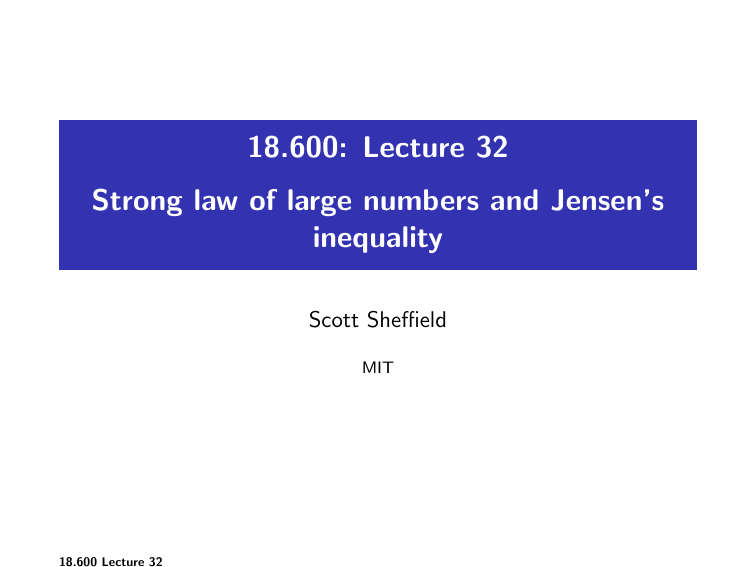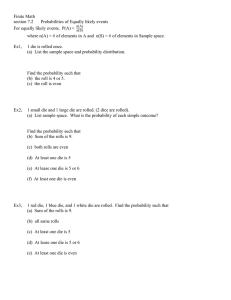18.600: Lecture 32 Strong law of large numbers and Jensen’s inequality Scott Sheffield
advertisement

18.600: Lecture 32
Strong law of large numbers and Jensen’s
inequality
Scott Sheffield
MIT
18.600 Lecture 32
Outline
A story about Pedro
Strong law of large numbers
Jensen’s inequality
18.600 Lecture 32
Outline
A story about Pedro
Strong law of large numbers
Jensen’s inequality
18.600 Lecture 32
Pedro’s hopes and dreams
I
Pedro is considering two ways to invest his life savings.
Pedro’s hopes and dreams
I
Pedro is considering two ways to invest his life savings.
I
One possibility: put the entire sum in government insured
interest-bearing savings account. He considers this completely
risk free. The (post-tax) interest rate equals the inflation rate,
so the real value of his savings is guaranteed not to change.
Pedro’s hopes and dreams
I
Pedro is considering two ways to invest his life savings.
I
One possibility: put the entire sum in government insured
interest-bearing savings account. He considers this completely
risk free. The (post-tax) interest rate equals the inflation rate,
so the real value of his savings is guaranteed not to change.
I
Riskier possibility: put sum in investment where every month
real value goes up 15 percent with probability .53 and down
15 percent with probability .47 (independently of everything
else).
18.600 Lecture 32
Pedro’s hopes and dreams
I
Pedro is considering two ways to invest his life savings.
I
One possibility: put the entire sum in government insured
interest-bearing savings account. He considers this completely
risk free. The (post-tax) interest rate equals the inflation rate,
so the real value of his savings is guaranteed not to change.
I
Riskier possibility: put sum in investment where every month
real value goes up 15 percent with probability .53 and down
15 percent with probability .47 (independently of everything
else).
I
How much does Pedro make in expectation over 10 years with
risky approach? 100 years?
Pedro’s hopes and dreams
I
How much does Pedro make in expectation over 10 years with
risky approach? 100 years?
Pedro’s hopes and dreams
I
How much does Pedro make in expectation over 10 years with
risky approach? 100 years?
I
Answer: let Ri be i.i.d. random variables each equal to 1.15
with probability .53 and .85 with probability .47. Total value
after n steps is initial investment times
Tn := R1 × R2 × . . . × Rn .
Pedro’s hopes and dreams
I
How much does Pedro make in expectation over 10 years with
risky approach? 100 years?
I
Answer: let Ri be i.i.d. random variables each equal to 1.15
with probability .53 and .85 with probability .47. Total value
after n steps is initial investment times
Tn := R1 × R2 × . . . × Rn .
I
Compute E [R1 ] = .53 × 1.15 + .47 × .85 = 1.009.
18.600 Lecture 32
Pedro’s hopes and dreams
I
How much does Pedro make in expectation over 10 years with
risky approach? 100 years?
I
Answer: let Ri be i.i.d. random variables each equal to 1.15
with probability .53 and .85 with probability .47. Total value
after n steps is initial investment times
Tn := R1 × R2 × . . . × Rn .
I
Compute E [R1 ] = .53 × 1.15 + .47 × .85 = 1.009.
I
Then E [T120 ] = 1.009120 ≈ 2.93. And
E [T1200 ] = 1.0091200 ≈ 46808.9
18.600 Lecture 32
Pedro’s financial planning
I
How would you advise Pedro to invest over the next 10 years
if Pedro wants to be completely sure that he doesn’t lose
money?
18.600 Lecture 32
Pedro’s financial planning
I
How would you advise Pedro to invest over the next 10 years
if Pedro wants to be completely sure that he doesn’t lose
money?
I
What if Pedro is willing to accept substantial risk if it means
there is a good chance it will enable his grandchildren to retire
in comfort 100 years from now?
18.600 Lecture 32
Pedro’s financial planning
I
How would you advise Pedro to invest over the next 10 years
if Pedro wants to be completely sure that he doesn’t lose
money?
I
What if Pedro is willing to accept substantial risk if it means
there is a good chance it will enable his grandchildren to retire
in comfort 100 years from now?
I
What if Pedro wants the money for himself in ten years?
18.600 Lecture 32
Pedro’s financial planning
I
How would you advise Pedro to invest over the next 10 years
if Pedro wants to be completely sure that he doesn’t lose
money?
I
What if Pedro is willing to accept substantial risk if it means
there is a good chance it will enable his grandchildren to retire
in comfort 100 years from now?
I
What if Pedro wants the money for himself in ten years?
I
Let’s do some simulations.
18.600 Lecture 32
Logarithmic point of view
I
We wrote Tn = R1 × . . . × Rn . P
Taking logs, we can write
Xi = log Ri and Sn = log Tn = ni=1 Xi .
Logarithmic point of view
I
We wrote Tn = R1 × . . . × Rn . P
Taking logs, we can write
Xi = log Ri and Sn = log Tn = ni=1 Xi .
I
Now Sn is a sum of i.i.d. random variables.
Logarithmic point of view
I
We wrote Tn = R1 × . . . × Rn . P
Taking logs, we can write
Xi = log Ri and Sn = log Tn = ni=1 Xi .
I
Now Sn is a sum of i.i.d. random variables.
I
E [X1 ] = E [log R1 ] = .53(log 1.15) + .47(log .85) ≈ −.0023.
Logarithmic point of view
I
We wrote Tn = R1 × . . . × Rn . P
Taking logs, we can write
Xi = log Ri and Sn = log Tn = ni=1 Xi .
I
Now Sn is a sum of i.i.d. random variables.
I
E [X1 ] = E [log R1 ] = .53(log 1.15) + .47(log .85) ≈ −.0023.
I
By the law of large numbers, if we take n extremely large,
then Sn /n ≈ −.0023 with high probability.
Logarithmic point of view
I
We wrote Tn = R1 × . . . × Rn . P
Taking logs, we can write
Xi = log Ri and Sn = log Tn = ni=1 Xi .
I
Now Sn is a sum of i.i.d. random variables.
I
E [X1 ] = E [log R1 ] = .53(log 1.15) + .47(log .85) ≈ −.0023.
I
By the law of large numbers, if we take n extremely large,
then Sn /n ≈ −.0023 with high probability.
I
This means that, when n is large, Sn is usually a very negative
value, which means Tn is usually very close to zero (even
though its expectation is very large).
Logarithmic point of view
I
We wrote Tn = R1 × . . . × Rn . P
Taking logs, we can write
Xi = log Ri and Sn = log Tn = ni=1 Xi .
I
Now Sn is a sum of i.i.d. random variables.
I
E [X1 ] = E [log R1 ] = .53(log 1.15) + .47(log .85) ≈ −.0023.
I
By the law of large numbers, if we take n extremely large,
then Sn /n ≈ −.0023 with high probability.
I
This means that, when n is large, Sn is usually a very negative
value, which means Tn is usually very close to zero (even
though its expectation is very large).
I
Bad news for Pedro’s grandchildren. After 100 years, the
portfolio is probably in bad shape. But what if Pedro takes an
even longer view? Will Tn converge to zero with probability
one as n gets large? Or will Tn perhaps always eventually
rebound?
Outline
A story about Pedro
Strong law of large numbers
Jensen’s inequality
18.600 Lecture 32
Outline
A story about Pedro
Strong law of large numbers
Jensen’s inequality
18.600 Lecture 32
Strong law of large numbers
I
Suppose Xi are i.i.d. random variables with mean µ.
18.600 Lecture 32
Strong law of large numbers
I
I
Suppose Xi are i.i.d. random variables with mean µ.
n
is called the empirical
Then the value An := X1 +X2 +...+X
n
average of the first n trials.
18.600 Lecture 32
Strong law of large numbers
I
I
I
Suppose Xi are i.i.d. random variables with mean µ.
n
is called the empirical
Then the value An := X1 +X2 +...+X
n
average of the first n trials.
Intuition: when n is large, An is typically close to µ.
18.600 Lecture 32
Strong law of large numbers
I
I
Suppose Xi are i.i.d. random variables with mean µ.
n
is called the empirical
Then the value An := X1 +X2 +...+X
n
average of the first n trials.
I
Intuition: when n is large, An is typically close to µ.
I
Recall: weak law of large numbers states that for all > 0
we have limn→∞ P{|An − µ| > } = 0.
18.600 Lecture 32
Strong law of large numbers
I
I
Suppose Xi are i.i.d. random variables with mean µ.
n
is called the empirical
Then the value An := X1 +X2 +...+X
n
average of the first n trials.
I
Intuition: when n is large, An is typically close to µ.
I
Recall: weak law of large numbers states that for all > 0
we have limn→∞ P{|An − µ| > } = 0.
I
The strong law of large numbers states that with
probability one limn→∞ An = µ.
18.600 Lecture 32
Strong law of large numbers
I
I
Suppose Xi are i.i.d. random variables with mean µ.
n
is called the empirical
Then the value An := X1 +X2 +...+X
n
average of the first n trials.
I
Intuition: when n is large, An is typically close to µ.
I
Recall: weak law of large numbers states that for all > 0
we have limn→∞ P{|An − µ| > } = 0.
I
The strong law of large numbers states that with
probability one limn→∞ An = µ.
I
It is called “strong” because it implies the weak law of large
numbers. But it takes a bit of thought to see why this is the
case.
18.600 Lecture 32
Strong law implies weak law
I
Suppose we know that the strong law holds, i.e., with
probability 1 we have limn→∞ An = µ.
Strong law implies weak law
I
Suppose we know that the strong law holds, i.e., with
probability 1 we have limn→∞ An = µ.
I
Strong law implies that for every the random variable
Y = max{n : |An − µ| > } is finite with probability one. It
has some probability mass function (though we don’t know
what it is).
Strong law implies weak law
I
Suppose we know that the strong law holds, i.e., with
probability 1 we have limn→∞ An = µ.
I
Strong law implies that for every the random variable
Y = max{n : |An − µ| > } is finite with probability one. It
has some probability mass function (though we don’t know
what it is).
I
Note that if |An − µ| > for some n value then Y ≥ n.
Strong law implies weak law
I
Suppose we know that the strong law holds, i.e., with
probability 1 we have limn→∞ An = µ.
I
Strong law implies that for every the random variable
Y = max{n : |An − µ| > } is finite with probability one. It
has some probability mass function (though we don’t know
what it is).
I
Note that if |An − µ| > for some n value then Y ≥ n.
I
Thus for each n we have P{|An − µ| > } ≤ P{Y ≥ n}.
Strong law implies weak law
I
Suppose we know that the strong law holds, i.e., with
probability 1 we have limn→∞ An = µ.
I
Strong law implies that for every the random variable
Y = max{n : |An − µ| > } is finite with probability one. It
has some probability mass function (though we don’t know
what it is).
I
Note that if |An − µ| > for some n value then Y ≥ n.
I
Thus for each n we have P{|An − µ| > } ≤ P{Y ≥ n}.
I
So limn→∞ P{|An − µ| > } ≤ limn→∞ P{Y ≥ n} = 0.
Strong law implies weak law
I
Suppose we know that the strong law holds, i.e., with
probability 1 we have limn→∞ An = µ.
I
Strong law implies that for every the random variable
Y = max{n : |An − µ| > } is finite with probability one. It
has some probability mass function (though we don’t know
what it is).
I
Note that if |An − µ| > for some n value then Y ≥ n.
I
Thus for each n we have P{|An − µ| > } ≤ P{Y ≥ n}.
I
So limn→∞ P{|An − µ| > } ≤ limn→∞ P{Y ≥ n} = 0.
I
If the right limit is zero for each (strong law) then the left
limit is zero for each (weak law).
18.600 Lecture 32
Proof of strong law assuming E [X 4 ] < ∞
I
Assume K := E [X 4 ] < ∞. Not necessary, but simplifies proof.
Proof of strong law assuming E [X 4 ] < ∞
I
I
Assume K := E [X 4 ] < ∞. Not necessary, but simplifies proof.
Note: Var[X 2 ] = E [X 4 ] − E [X 2 ]2 > 0, so E [X 2 ]2 ≤ K .
18.600 Lecture 32
Proof of strong law assuming E [X 4 ] < ∞
I
I
I
Assume K := E [X 4 ] < ∞. Not necessary, but simplifies proof.
Note: Var[X 2 ] = E [X 4 ] − E [X 2 ]2 > 0, so E [X 2 ]2 ≤ K .
The strong law holds for i.i.d. copies of X if and only if it
holds for i.i.d. copies of X − µ where µ is a constant.
Proof of strong law assuming E [X 4 ] < ∞
I
I
I
I
Assume K := E [X 4 ] < ∞. Not necessary, but simplifies proof.
Note: Var[X 2 ] = E [X 4 ] − E [X 2 ]2 > 0, so E [X 2 ]2 ≤ K .
The strong law holds for i.i.d. copies of X if and only if it
holds for i.i.d. copies of X − µ where µ is a constant.
So we may as well assume E [X ] = 0.
Proof of strong law assuming E [X 4 ] < ∞
I
I
I
I
I
Assume K := E [X 4 ] < ∞. Not necessary, but simplifies proof.
Note: Var[X 2 ] = E [X 4 ] − E [X 2 ]2 > 0, so E [X 2 ]2 ≤ K .
The strong law holds for i.i.d. copies of X if and only if it
holds for i.i.d. copies of X − µ where µ is a constant.
So we may as well assume E [X ] = 0.
Key to proof is to bound fourth moments of An .
18.600 Lecture 32
Proof of strong law assuming E [X 4 ] < ∞
I
I
I
I
I
I
Assume K := E [X 4 ] < ∞. Not necessary, but simplifies proof.
Note: Var[X 2 ] = E [X 4 ] − E [X 2 ]2 > 0, so E [X 2 ]2 ≤ K .
The strong law holds for i.i.d. copies of X if and only if it
holds for i.i.d. copies of X − µ where µ is a constant.
So we may as well assume E [X ] = 0.
Key to proof is to bound fourth moments of An .
E [A4n ] = n−4 E [Sn4 ] = n−4 E [(X1 + X2 + . . . + Xn )4 ].
18.600 Lecture 32
Proof of strong law assuming E [X 4 ] < ∞
I
I
I
I
I
I
I
Assume K := E [X 4 ] < ∞. Not necessary, but simplifies proof.
Note: Var[X 2 ] = E [X 4 ] − E [X 2 ]2 > 0, so E [X 2 ]2 ≤ K .
The strong law holds for i.i.d. copies of X if and only if it
holds for i.i.d. copies of X − µ where µ is a constant.
So we may as well assume E [X ] = 0.
Key to proof is to bound fourth moments of An .
E [A4n ] = n−4 E [Sn4 ] = n−4 E [(X1 + X2 + . . . + Xn )4 ].
Expand (X1 + . . . + Xn )4 . Five kinds of terms: Xi Xj Xk Xl and
Xi Xj Xk2 and Xi Xj3 and Xi2 Xj2 and Xi4 .
18.600 Lecture 32
Proof of strong law assuming E [X 4 ] < ∞
I
I
I
I
I
I
I
I
Assume K := E [X 4 ] < ∞. Not necessary, but simplifies proof.
Note: Var[X 2 ] = E [X 4 ] − E [X 2 ]2 > 0, so E [X 2 ]2 ≤ K .
The strong law holds for i.i.d. copies of X if and only if it
holds for i.i.d. copies of X − µ where µ is a constant.
So we may as well assume E [X ] = 0.
Key to proof is to bound fourth moments of An .
E [A4n ] = n−4 E [Sn4 ] = n−4 E [(X1 + X2 + . . . + Xn )4 ].
Expand (X1 + . . . + Xn )4 . Five kinds of terms: Xi Xj Xk Xl and
Xi Xj Xk2 and Xi Xj3 and Xi2 Xj2 and Xi4 .
The first three terms all have expectation zero. There are n2
of the fourth type and n of
the last type, each equal to at
4
−4
most K . So E [An ] ≤ n
6 n2 + n K .
18.600 Lecture 32
Proof of strong law assuming E [X 4 ] < ∞
I
I
I
I
I
I
I
I
I
Assume K := E [X 4 ] < ∞. Not necessary, but simplifies proof.
Note: Var[X 2 ] = E [X 4 ] − E [X 2 ]2 > 0, so E [X 2 ]2 ≤ K .
The strong law holds for i.i.d. copies of X if and only if it
holds for i.i.d. copies of X − µ where µ is a constant.
So we may as well assume E [X ] = 0.
Key to proof is to bound fourth moments of An .
E [A4n ] = n−4 E [Sn4 ] = n−4 E [(X1 + X2 + . . . + Xn )4 ].
Expand (X1 + . . . + Xn )4 . Five kinds of terms: Xi Xj Xk Xl and
Xi Xj Xk2 and Xi Xj3 and Xi2 Xj2 and Xi4 .
The first three terms all have expectation zero. There are n2
of the fourth type and n of
the last type, each equal to at
4
−4
most K . So E [An ] ≤ n
6 n2 + n K .
P
P∞
P∞
4
4
4
Thus E [ ∞
n=1 An ] =
n=1 E [An ] < ∞. So
n=1 An < ∞
(and hence An → 0) with probability 1.
Outline
A story about Pedro
Strong law of large numbers
Jensen’s inequality
18.600 Lecture 32
Outline
A story about Pedro
Strong law of large numbers
Jensen’s inequality
18.600 Lecture 32
Jensen’s inequality statement
I
Let X be random variable with finite mean E [X ] = µ.
Jensen’s inequality statement
I
I
Let X be random variable with finite mean E [X ] = µ.
Let g be a convex function. This means that if you draw a
straight line connecting two points on the graph of g , then
the graph of g lies below that line. If g is twice differentiable,
then convexity is equivalent to the statement that g 00 (x) ≥ 0
for all x. For a concrete example, take g (x) = x 2 .
Jensen’s inequality statement
I
I
I
Let X be random variable with finite mean E [X ] = µ.
Let g be a convex function. This means that if you draw a
straight line connecting two points on the graph of g , then
the graph of g lies below that line. If g is twice differentiable,
then convexity is equivalent to the statement that g 00 (x) ≥ 0
for all x. For a concrete example, take g (x) = x 2 .
Jensen’s inequality: E [g (X )] ≥ g (E [X ]).
Jensen’s inequality statement
I
I
I
I
Let X be random variable with finite mean E [X ] = µ.
Let g be a convex function. This means that if you draw a
straight line connecting two points on the graph of g , then
the graph of g lies below that line. If g is twice differentiable,
then convexity is equivalent to the statement that g 00 (x) ≥ 0
for all x. For a concrete example, take g (x) = x 2 .
Jensen’s inequality: E [g (X )] ≥ g (E [X ]).
Proof: Let L(x) = ax + b be tangent to graph of g at point
(E [X ], g (E [X ])). Then L lies below g . Observe
E [g (X )] ≥ E [L(X )] = L(E [X ]) = g (E [X )]
Jensen’s inequality statement
I
I
I
I
Let X be random variable with finite mean E [X ] = µ.
Let g be a convex function. This means that if you draw a
straight line connecting two points on the graph of g , then
the graph of g lies below that line. If g is twice differentiable,
then convexity is equivalent to the statement that g 00 (x) ≥ 0
for all x. For a concrete example, take g (x) = x 2 .
Jensen’s inequality: E [g (X )] ≥ g (E [X ]).
Proof: Let L(x) = ax + b be tangent to graph of g at point
(E [X ], g (E [X ])). Then L lies below g . Observe
E [g (X )] ≥ E [L(X )] = L(E [X ]) = g (E [X )]
I
Note: if g is concave (which means −g is convex), then
E [g (X )] ≤ g (E [X ]).
Jensen’s inequality statement
I
I
I
I
Let X be random variable with finite mean E [X ] = µ.
Let g be a convex function. This means that if you draw a
straight line connecting two points on the graph of g , then
the graph of g lies below that line. If g is twice differentiable,
then convexity is equivalent to the statement that g 00 (x) ≥ 0
for all x. For a concrete example, take g (x) = x 2 .
Jensen’s inequality: E [g (X )] ≥ g (E [X ]).
Proof: Let L(x) = ax + b be tangent to graph of g at point
(E [X ], g (E [X ])). Then L lies below g . Observe
E [g (X )] ≥ E [L(X )] = L(E [X ]) = g (E [X )]
I
I
Note: if g is concave (which means −g is convex), then
E [g (X )] ≤ g (E [X ]).
If your utility function is concave, then you always prefer a
safe investment over a risky investment with the same
expected return.
More about Pedro
I
Disappointed by the strong law of large numbers, Pedro seeks
a better way to make money.
More about Pedro
I
I
Disappointed by the strong law of large numbers, Pedro seeks
a better way to make money.
Signs up for job as “hedge fund manager”. Allows him to
manage C ≈ 109 dollars of somebody else’s money. At end of
each year, he and his staff get two percent of principle plus
twenty percent of profit.
More about Pedro
I
I
I
Disappointed by the strong law of large numbers, Pedro seeks
a better way to make money.
Signs up for job as “hedge fund manager”. Allows him to
manage C ≈ 109 dollars of somebody else’s money. At end of
each year, he and his staff get two percent of principle plus
twenty percent of profit.
Precisely: if X is end-of-year portfolio value, Pedro gets
g (X ) = .02C + .2 max{X − C , 0}.
More about Pedro
I
I
I
Disappointed by the strong law of large numbers, Pedro seeks
a better way to make money.
Signs up for job as “hedge fund manager”. Allows him to
manage C ≈ 109 dollars of somebody else’s money. At end of
each year, he and his staff get two percent of principle plus
twenty percent of profit.
Precisely: if X is end-of-year portfolio value, Pedro gets
g (X ) = .02C + .2 max{X − C , 0}.
I
Pedro notices that g is a convex function. He can therefore
increase his expected return by adopting risky strategies.
More about Pedro
I
I
I
Disappointed by the strong law of large numbers, Pedro seeks
a better way to make money.
Signs up for job as “hedge fund manager”. Allows him to
manage C ≈ 109 dollars of somebody else’s money. At end of
each year, he and his staff get two percent of principle plus
twenty percent of profit.
Precisely: if X is end-of-year portfolio value, Pedro gets
g (X ) = .02C + .2 max{X − C , 0}.
I
I
Pedro notices that g is a convex function. He can therefore
increase his expected return by adopting risky strategies.
Pedro has strategy that increases portfolio value 10 percent
with probability .9, loses everything with probability .1.
More about Pedro
I
I
I
Disappointed by the strong law of large numbers, Pedro seeks
a better way to make money.
Signs up for job as “hedge fund manager”. Allows him to
manage C ≈ 109 dollars of somebody else’s money. At end of
each year, he and his staff get two percent of principle plus
twenty percent of profit.
Precisely: if X is end-of-year portfolio value, Pedro gets
g (X ) = .02C + .2 max{X − C , 0}.
I
I
I
Pedro notices that g is a convex function. He can therefore
increase his expected return by adopting risky strategies.
Pedro has strategy that increases portfolio value 10 percent
with probability .9, loses everything with probability .1.
He repeats this yearly until fund collapses.
More about Pedro
I
I
I
Disappointed by the strong law of large numbers, Pedro seeks
a better way to make money.
Signs up for job as “hedge fund manager”. Allows him to
manage C ≈ 109 dollars of somebody else’s money. At end of
each year, he and his staff get two percent of principle plus
twenty percent of profit.
Precisely: if X is end-of-year portfolio value, Pedro gets
g (X ) = .02C + .2 max{X − C , 0}.
I
I
I
I
Pedro notices that g is a convex function. He can therefore
increase his expected return by adopting risky strategies.
Pedro has strategy that increases portfolio value 10 percent
with probability .9, loses everything with probability .1.
He repeats this yearly until fund collapses.
With high probability Pedro is rich by then.
Perspective
I
The “two percent of principle plus twenty percent of profit” is
common in the hedge fund industry.
Perspective
I
The “two percent of principle plus twenty percent of profit” is
common in the hedge fund industry.
I
The idea is that fund managers have both guaranteed revenue
for expenses (two percent of principle) and incentive to make
money (twenty percent of profit).
Perspective
I
The “two percent of principle plus twenty percent of profit” is
common in the hedge fund industry.
I
The idea is that fund managers have both guaranteed revenue
for expenses (two percent of principle) and incentive to make
money (twenty percent of profit).
I
Because of Jensen’s inequality, the convexity of the payoff
function is a genuine concern for hedge fund investors. People
worry that it encourages fund managers (like Pedro) to take
risks that are bad for the client.
Perspective
I
The “two percent of principle plus twenty percent of profit” is
common in the hedge fund industry.
I
The idea is that fund managers have both guaranteed revenue
for expenses (two percent of principle) and incentive to make
money (twenty percent of profit).
I
Because of Jensen’s inequality, the convexity of the payoff
function is a genuine concern for hedge fund investors. People
worry that it encourages fund managers (like Pedro) to take
risks that are bad for the client.
I
This is a special case of the “principal-agent” problem of
economics. How do you ensure that the people you hire
genuinely share your interests?





